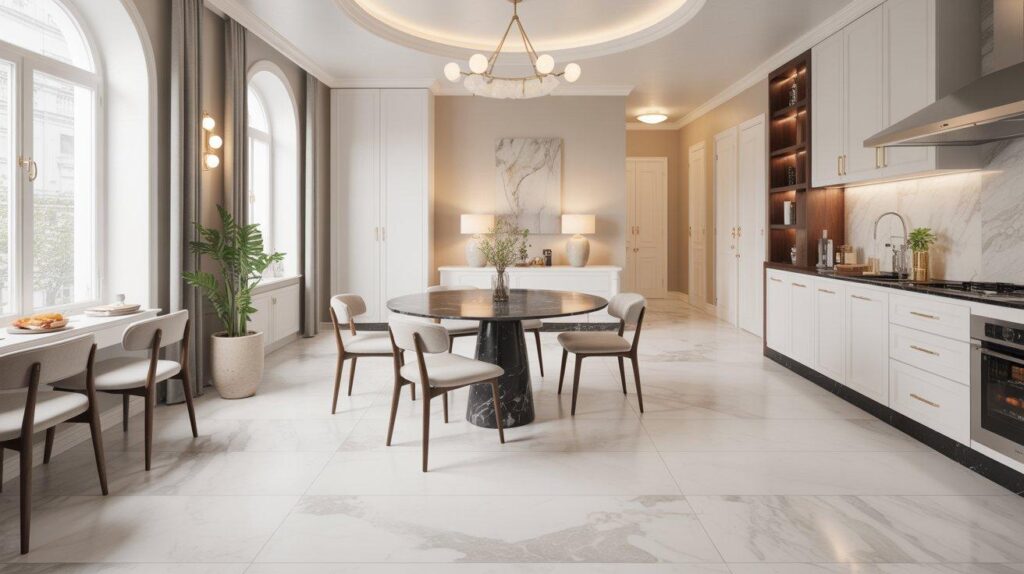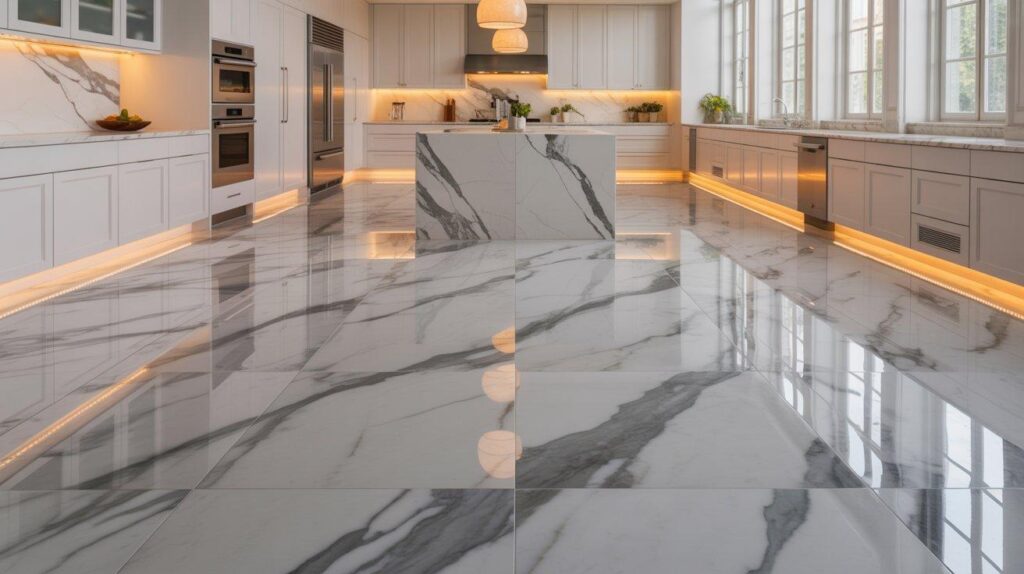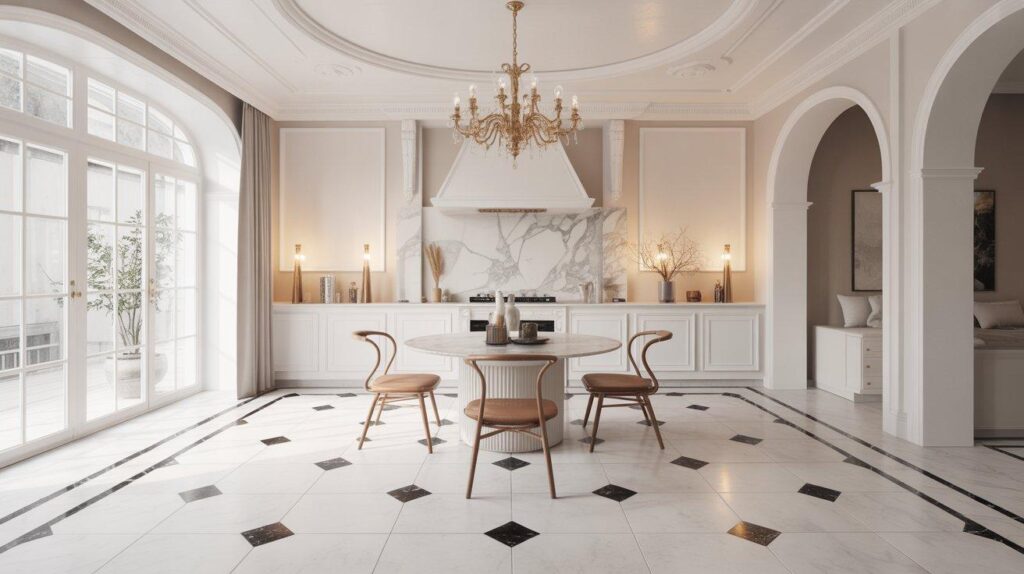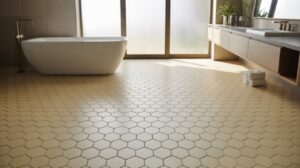How to Clean Swimming Pool Tiles: A Complete Professional Guide Cleaning swimming pool tiles is...
Read MoreExpert Marble Floor Installation in Lowell, MA
Marble Floor Installation
Step onto luxury every morning with a marble floor that reflects your taste and adds lasting beauty to your home. At SF Marble & Granite Inc., we specialize in marble floor installation in Lowell MA, creating spaces that feel as sophisticated as they look. Whether you’re renovating your kitchen, bathroom, or hallway, our expert installers handle every detail, from preparation to sealing, with precision and care.
Installing a marble floor typically costs $8–$28 per sq ft, including materials and labor, depending on marble quality and design. The installation process involves preparing a level and strong subfloor, laying a cement backer board or mortar underlayment, “buttering” the back of each marble tile, tapping it into place, spacing the joints, and then sealing before grouting.
A rigid, properly supported subfloor is essential to prevent flexing and cracks. Marble isn’t always preferred for flooring because it’s soft, porous, and sensitive to acids—it scratches, chips, stains easily, and can crack if not installed carefully. For cleaning, Dawn dish soap is mildly safe in very dilute form, but pH-neutral stone cleaners are better. Marble floors can crack if the subfloor isn’t stable or lacks proper expansion joints.

Why Homeowners in Lowell Choose Marble Floors
If you are looking for a flooring option that’s both elegant and durable, marble is hard to beat. It instantly elevates your interiors while standing strong against time. Many homeowners in Lowell MA choose marble for its:
Timeless beauty: a polished finish that never goes out of style.
High property value: marble adds instant market appeal.
Long-lasting durability: with proper installation and sealing, it lasts for decades.
Cool comfort: ideal for New England’s warmer months.
When installed by professionals, marble flooring transforms any space into something truly remarkable.
Our Process for Marble Floor Tile Installation in Lowell MA
Every great marble floor begins with the right foundation. Here’s how we make your dream floor a reality:
Inspection & Preparation
We start by checking your subfloor for moisture, level, and stability. Any imperfections are fixed to ensure a flawless surface.Design & Layout Planning
Together, we select the ideal marble style, color, and pattern that best complements your home’s character.Precision Cutting & Placement
Using advanced cutting tools, we ensure each tile fits perfectly. Our installers align every seam for a seamless look.Professional Setting & Grouting
We apply premium thin-set mortar, set each marble tile, and fill joints with matching grout for a uniform finish.Sealing & Finishing Touches
Once cured, your marble is sealed to protect it from stains, spills, and daily wear. The result; smooth, shining perfection.
If you have ever wondered how to install marble floor tile in Lowell MA, this is the professional standard we follow; clean, careful, and built to last.

Avoid the Common Mistakes of DIY Installation
Many homeowners try installing marble tiles themselves to save costs, but end up with uneven floors, cracks, or water damage later. Marble is heavy, porous, and needs expert handling.
With our skilled team:No messy grout lines or uneven edges.
No surprise repairs after installation.
Guaranteed professional results, every time.
Save yourself the stress. Let certified installers handle it right the first time.
Marble Floor Installation Cost in Lowell MA
Every home is unique, and so is every project. The cost of marble floor installation in Lowell MA depends on:
The type and grade of marble you choose.
The size and layout of your space.
Subfloor preparation requirements.
Any custom designs or patterns requested.
We provide free on-site estimates and clear, transparent pricing before starting work, so there are no hidden surprises. Quality marble flooring is an investment that adds both beauty and long-term value to your property.

Why Choose SF Marble & Granite Inc.
When you trust us for installing marble floor tile in Lowell, MA, you get more than a contractor; you get a dedicated local team that cares about craftsmanship.
Over 10 years of local experience in marble, granite, and tile installation.
Licensed, insured, and background-checked installers.
On-time, professional service: we arrive in uniform, with the right tools.
Guaranteed workmanship: if it’s not perfect, we’ll make it right.
Our clients choose us because we make their homes look extraordinary, and we treat every project like our own.
Ready to Elevate Your Home?
Bring your space to life with a floor that defines elegance and quality. Whether you want a single-room upgrade or a full-home marble transformation, SF Marble & Granite Inc. is your trusted choice for marble floor installation in Lowell, MA.
Call us today or request a free consultation to discuss your marble flooring goals. Let’s create a floor that tells your story, beautiful, durable, and built to impress.
FAQs
Can Marble Flooring Be Installed On Any Surface?
Yes, but the existing floor must be level, stable, and in good condition. We’ll assess your subfloor to ensure proper adhesion and prevent future issues.
How Long Does Marble Floor Installation Take?
Installation time varies depending on the project size, complexity, and marble type. Most installations can be completed within 1 to 2 days.
How Do I Care For My New Marble Floors?
Regularly clean with a pH-neutral cleaner, promptly wipe up spills, and reseal annually to protect against stains and scratches.
Is Marble Flooring Slippery?
Marble can be slippery, especially when wet. Honed or textured finishes offer better traction than polished surfaces.
What Is The Difference Between Polished And Honed Marble?
Polished marble is glossy and reflective, while honed marble has a matte finish. Polished marble is more prone to scratches, while honed marble offers better slip resistance.
Our Services
Contact Us
- 755 Dutton St. Lowell-MA 01854
- Phone: 978-459-5823
- FAX: 978 459 5827
- smgranite@hotmail.com
Our Blogs
Bathrooms with Hexagon Tile Floors: Style, Function, and Timeless Appeal
Bathrooms with Hexagon Tile Floors: Style, Function, and Timeless Appeal Bathrooms with hexagon tile floors...
Read MoreWondering About: Cost to Repair Crack in Granite Countertop, Here is The Complete Breakdown By Experts
Wondering About: Cost to Repair Crack in Granite Countertop, Here is The Complete Breakdown By...
Read More


